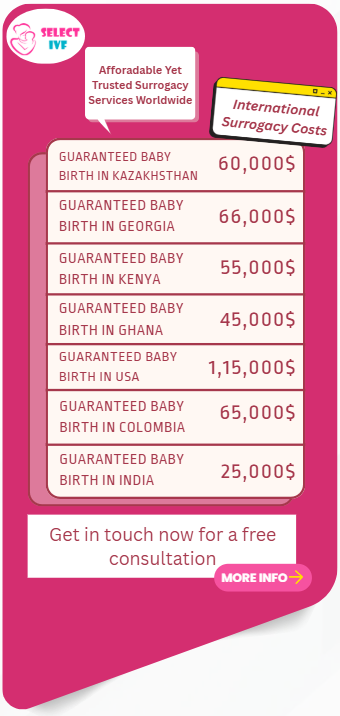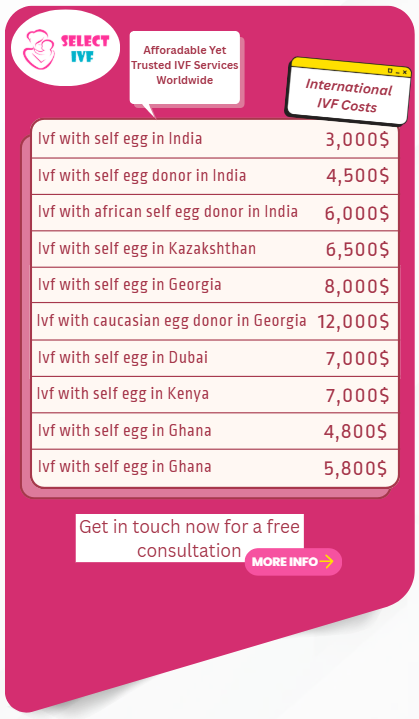In-vitro fertilization (IVF) is a revolutionary technique that has helped countless couples fulfill their dream of becoming parents. However, not every IVF cycle results in a successful pregnancy, especially when genetic or chromosomal abnormalities are involved. This is where advanced genetic screening methods like PGD and PGS come into play.
These techniques allow doctors to examine embryos before implantation, ensuring that only healthy ones are transferred into the uterus. PGD helps detect specific inherited diseases, while PGS checks for chromosomal abnormalities that could cause miscarriage or failed implantation. By identifying potential issues early, these tests improve IVF success rates, reduce the risk of genetic disorders, and offer couples greater confidence in their fertility journey. In this article, we will explore what PGD and PGS are, how they work, who can benefit from them, and why they are becoming essential tools in modern IVF treatments.
Why should you trust SELECT IVF for INDIA?
- First-stage top counseling sessions
- Premium services and processes
- Highly competent specialists for PGD & PGS Testing in IVF
- Contact us Email ID: info@selectivf.com
- Call us: +91 – 8447592299
What is PGD (Preimplantation Genetic Diagnosis)?
PGD is a technique used during IVF to test embryos for specific genetic diseases or disorders inherited from parents. It helps detect single-gene mutations, like cystic fibrosis or thalassemia, before embryo transfer.
In PGD, a few cells are taken from an embryo on day 5 or 6 of development (blastocyst stage). These cells are analyzed for known genetic conditions. Only embryos without those specific diseases are selected for implantation. PGD is most useful for couples with a known family history of genetic disorders and helps prevent the transmission of life-threatening conditions to the child.
What is PGS (Preimplantation Genetic Screening)?
PGS, now commonly called PGT-A (Preimplantation Genetic Testing for Aneuploidy), checks embryos for chromosomal abnormalities. It ensures the right number of chromosomes are present, reducing the risk of miscarriage or failed implantation.
Unlike PGD, PGS doesn’t test for specific diseases. Instead, it looks at whether the embryo has a normal chromosomal number (euploid) or an abnormal number (aneuploid). This is especially helpful for older women, as age increases the chance of chromosomal issues like Down syndrome. PGS helps select the healthiest embryos for transfer, increasing IVF success and reducing pregnancy risks.
Difference Between PGD and PGS
While both PGD (Preimplantation Genetic Diagnosis) and PGS (Preimplantation Genetic Screening, now referred to as PGT-A) are genetic tests performed during the IVF process, they serve very different purposes and are recommended for different reasons. The most important difference lies in what each test looks for and who it is meant for.
PGD is used to identify specific genetic mutations that may be passed from parents to their children. These mutations can cause serious, often life-threatening conditions such as cystic fibrosis, Tay-Sachs disease, muscular dystrophy, thalassemia, or sickle cell anemia. PGD is typically recommended for couples who are known carriers of a genetic disorder or who already have a child affected by such a disease. Through PGD, embryos that carry these defective genes can be avoided during transfer, significantly reducing the risk of the child inheriting a genetic condition.
PGS, on the other hand, is not focused on specific diseases but instead checks the overall chromosomal health of embryos. It ensures that each embryo has the correct number of chromosomes 46 in total, arranged in 23 pairs. Embryos with too few or too many chromosomes (aneuploidy) often result in failed implantation, miscarriage, or conditions such as Down syndrome. PGS is especially beneficial for women over 35, couples with a history of recurrent miscarriage, or those who have experienced repeated IVF failures.
In simple terms:
- PGD = Disease-focused – Targets specific inherited conditions
- PGS = Chromosome-focused – Screens for normal chromosomal count
Both PGD and PGS require embryos to be created through IVF, as the testing is done on embryos outside the body. Depending on a couple’s fertility history and genetic background, doctors may recommend either test or both to help increase the chances of a healthy, successful pregnancy.
How Are PGD and PGS Performed?
Both procedures start with standard IVF. After egg retrieval and fertilization, embryos grow for about five days. At the blastocyst stage, a few cells are gently removed from each embryo. These cells are sent for genetic analysis.
Advanced lab techniques like Next-Generation Sequencing (NGS) or array-CGH (Comparative Genomic Hybridization) are used to detect abnormalities. Once results are ready (usually within a few days), only healthy embryos are chosen for implantation. The remaining embryos may be frozen for future use.
This entire process is done under highly controlled conditions by embryologists and genetic specialists to ensure accuracy.
Benefits of PGD and PGS in IVF
1. Improved IVF Success Rates
By selecting genetically normal embryos, PGS improves the chances of successful implantation and pregnancy. It reduces the number of IVF cycles needed, saving time, emotional energy, and costs in the long run.
2. Lower Risk of Miscarriage
Many miscarriages result from chromosomal abnormalities. By transferring only normal embryos, PGS can significantly reduce the chances of miscarriage.
3. Avoidance of Genetic Disorders
PGD ensures that embryos carrying severe inherited disorders are not transferred, allowing couples to avoid passing on diseases like Tay-Sachs, thalassemia, or Huntington’s.
4. Healthier Babies
The ultimate goal of PGD/PGS is to increase the likelihood of a healthy baby. Selecting embryos with the right genetic makeup reduces health risks during pregnancy and after birth.
Who Should Consider PGD and PGS Testing?
These tests are particularly recommended in the following cases:
- Couples with a family history of genetic disorders (PGD)
- Women above 35 years (PGS)
- Recurrent IVF failure or miscarriage
- Male factor infertility with chromosomal abnormalities
- Carriers of single-gene disorders
- Couples with previous children affected by genetic diseases
While PGD and PGS aren’t required for every IVF cycle, they provide peace of mind and may improve the outcome for many patients with specific risks.
Are PGD and PGS Safe?
Yes, both tests are considered safe and do not harm the embryo when performed correctly by skilled embryologists. The cell biopsy is done carefully without affecting embryo development. However, like any medical procedure, there is a small risk of damage during cell extraction or errors in analysis.
Modern IVF labs follow strict safety protocols. Embryos are monitored closely, and only viable ones are selected for transfer. Over the years, thousands of healthy babies have been born following PGD and PGS, proving their safety and effectiveness.
Limitations and Ethical Considerations
Despite their benefits, PGD and PGS have some limitations:
- False positives or negatives: Not 100% accurate.
- Cost: Adds significant expense to IVF treatment.
- No guarantee of pregnancy: A healthy embryo may still not implant.
- Ethical concerns: Some worry about embryo selection leading to non-medical uses (like gender preference).
Clinics must offer proper counseling to help couples understand the risks, benefits, and ethical considerations. Each decision should be personalized based on medical advice and personal values.
Success Rates After PGD and PGS
Studies show that IVF cycles with PGS have higher implantation rates, especially in older women. The pregnancy rate per embryo transfer can reach 60–70% with PGS, compared to 30–40% without.
PGD has helped many families avoid serious hereditary diseases, offering a real chance at having a genetically healthy child. However, success still depends on other factors like egg quality, sperm health, and uterine condition. PGD/PGS improves odds but doesn’t guarantee success.
Cost of PGD and PGS Testing
While exact costs vary, both tests can add ₹80,000 to ₹2,00,000 to IVF treatment in India. The pricing depends on the clinic, technology used, and the number of embryos tested. Despite the cost, many couples find value in the peace of mind and higher success rates PGD/PGS offers.
In countries like the U.S., the cost can exceed $4,000–$7,000 per cycle. Some clinics offer bundled packages that include testing.
Future of Genetic Testing in IVF
The future is promising. With rapid advances in genomics, PGD and PGS will become more accurate, affordable, and accessible. Newer forms like PGT-M (for monogenic disorders) and PGT-SR (for structural rearrangements) offer even more precise diagnostics.
Non-invasive testing methods are also being researched, which might one day eliminate the need for embryo biopsy. In coming years, genetic screening may become a standard part of IVF.
What should you consider when selecting the top IVF clinic in India?
We understand how difficult it becomes to select the best option for your infertility treatment but do not get tense, as one of the best options is going to be suggested to you where the patient collaborates with highly experienced and qualified doctors. The patient will find it comfortable as the staff will always stand by them, away from all the worries that come to their mind. We offer all types of infertility treatment, so contact us today! To start, consider the following factors while selecting a location:
i. The patient-focused assistance of the centre
ii. Professionals with extensive education and experience
iii. Infrastructure that is well-built for maximum comfort and happiness
iv. The entire medical staff treats you with respect
v. Assists you throughout the entire process from the beginning
vi. Offers transparent fees and processes
You have the option of choosing IVF for all of these! So, reach out to us at +91- 9899293903 | Email ID: info@www.selectivf.com
Why pick Select IVF for PGD & PGS in India?
Several numbers of infertile couples trusted the select IVF for their bright future. We care for every patient who has issues of infertility. We understand the phase of infertility, and that’s why we want to assist you in your dream of achieving parenthood. The prices of PGD & PGS treatment are reasonable at our centre, We ensure the highest success rates, we keep transparency and ensure personalised care and support to our patients. Get the treatment from our clinic and make your life stress-free by hearing the giggling of your newborn.
Here’s why Select IVF is best for PGD & PGS treatment in India:
- The high success rate of PGD & PGS and other infertility treatments
- Several infertility treatments for different infertility issues
- Use of cutting-edge technologies
- Equipped with highly skilled and educated doctors
- Affordable prices for PGD & PGS and other infertility treatments
- Ensures utmost comfort and support during the procedure
Conclusion
PGD & PGS Testing in IVF represent the future of personalized IVF care. While not mandatory for everyone, they offer major advantages for couples with genetic risks, older mothers, or those facing recurrent IVF failure. By identifying the healthiest embryos, these tests increase the likelihood of successful pregnancy and reduce the chances of miscarriage or disease transmission.
If you’re undergoing IVF, talk to your fertility specialist about whether PGD or PGS is right for you. With the right guidance, technology, and care, your journey to parenthood can be a more confident and hopeful one.
Frequently Asked Questions (FAQs)
What is the difference between PGD and PGS?
PGD (Preimplantation Genetic Diagnosis) checks for specific genetic diseases like thalassemia or cystic fibrosis that may be inherited from the parents. PGS (now called PGT-A) checks for chromosomal abnormalities, such as extra or missing chromosomes. PGD is for known genetic risks; PGS is for overall embryo health.
Do PGD or PGS guarantee pregnancy?
No, PGD and PGS do not guarantee pregnancy. However, they increase the chances of a successful outcome by selecting embryos with the highest potential for implantation and healthy development.
Are PGD and PGS safe for embryos?
Yes, when performed by experienced embryologists, both procedures are generally safe. A few cells are removed from the embryo for testing without harming its ability to grow and implant.
Can PGD/PGS be used for gender selection?
While technically possible, gender selection for non-medical reasons is illegal in many countries, including India. PGD and PGS should be used strictly for medical purposes such as avoiding genetic diseases.
How long does it take to get PGD/PGS results?
Results typically take 5 to 10 days. During this time, embryos are usually frozen. Once results are available, healthy embryos can be transferred in a later IVF cycle.
Should all couples opt for PGD or PGS?
Not necessarily. These tests are most beneficial for couples with a history of genetic disorders, women over 35, those who have experienced recurrent miscarriages, or previous failed IVF attempts.
Read Also:



